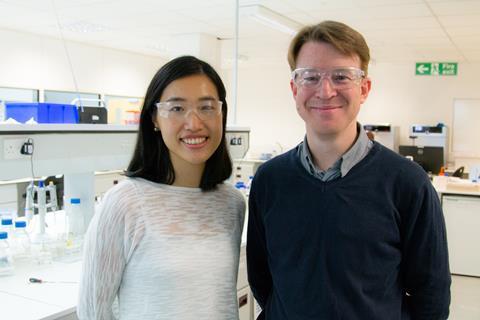‘Encapsulation is something we interact with every day, from the moment we get up in the morning,’ says Tim Wright, chief executive of Cambridge, UK-based Aqdot. All sorts of molecular ‘cargoes’, from delicate flavours and fragrances in food, to powerful enzymes in cleaning products, and even medicines, are encased in protective polymer coatings within the everyday products we buy.
But encapsulation is only effective if the cargo can be released at the right time, he explains: ‘What’s unique about Aqdot’s technology is our ability to chemically programme the encapsulation to trigger its release when and where the customer wants it to happen.’

The key to that triggering is a class of hollow, barrel-shaped molecules called cucurbiturils. Instead of covalently cross-linking the polymer shells, Aqdot uses supramolecular interactions. ‘There are certain chemicals that really like to go inside the cucurbituril, rather than staying outside,’ says Jing Zhang, Aqdot’s director of operations and co-founder. ‘You can imagine that acting like a kind of muff handwarmer, with two guest molecules sitting inside, and the cucurbituril going round them.’ Attaching these guest molecules to polymer chains means that the supramolecular interaction draws the polymers together to form a stable capsule shell around the cargo.
When it’s time to release the molecular cargo, the cucurbituril links can be interrupted by a variety of different stimuli, depending on the application. ‘We can tune the guest molecule that goes inside the cucurbituril to respond to pH, temperature, pressure, competitive binding of another guest molecule, or simple mechanical movement,’ Zhang explains. ‘Some guests are really good for a light trigger. So if a light shines on it, it changes molecular form, and breaks open the links.’
The company emerged when Zhang and husband Roger Coulston were both working at the University of Cambridge. ‘I was a PhD student in Chris Abell’s group, working on microfluidic droplets – making tiny aqueous droplets in oil, using a micron-sized channel,’ says Zhang. ‘Roger was working in Oren Scherman’s group on the other side of the building. He was using supramolecular chemistry to link polymers together to form a gel. We were chatting one day and we started wondering what would happen if we put his chemistry into the droplets I was making.’
‘We did the experiment and it turned out really interesting. The four of us got together, had a bit more of a look at it and decided to patent it, then publish it. The technology was born, and the company was born,’ she explains.
Wright explains that, while the flexibility of the technology makes it applicable across a variety of industries, the company needs to focus its efforts on a few sectors to build up customer relationships and get a foothold in the industry. Winning the Royal Society of Chemistry’s Emerging Technologies competition in 2013 gave the company access to mentors from GlaxoSmithKline, Croda and Procter & Gamble, Coulston explains, who were very helpful in shaping the company’s development plans.

‘For near term commercialisation, our market research has led us to focus in the areas of fragrances, household products, and biological washing detergents, as well as some niche industrial uses around epoxy resins and resin curing, where regulatory hurdles are relatively low and time to market is fast. This enables us to build confidence internally, for our investors and most importantly our customers,’ Wright says. The commercialisation strategy will depend on the application, he adds. ‘Typically it will involve some time demonstrating that the technology works – normally through a licensing deal, possibly with some joint development work. We will then manufacture and supply the encapsulation materials. Some customers prefer for us to take control of the encapsulation process, while others prefer to manage that in-house – we can be quite flexible.’
Alongside that, the team is working to scale up Aqdot’s manufacturing capabilities. In the longer term, Wright sees the technology being applied in pharmaceuticals and agrochemicals, where the regulatory requirements are higher and timescales can be longer. ‘Our ideal is to see products where it says on the packaging that there is “Aqdot inside”. However, there is certainly a scenario where it’s very quietly – but very widely – included in a lot of products,’ he says. ’We’re very excited about the future.’



























No comments yet